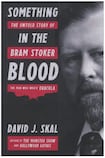
Bram Stoker's Dracula (1897) lies at the heart of the eerie blossoming of literary gothic that occurred in the English language in the late 19th century. Of all the works that contributed to that dark flowering (one thinks of the ghost stories of MR James of the 1890s, of Robert Louis Stevenson's Dr Jekyll and Mr Hyde (1886), of Henry James's The Turn of the Screw (1898)), it was Stoker's novel that did the most to register and popularise the lineaments of the gothic, and inaugurate its extraordinary 20th-century afterlife. Look at the cultural and intellectual life of the past century and more, and the influence of Dracula can be seen almost everywhere: in cinema, in video games, in art, in literature, in fashion, in design, in the phrases of our language and in the images of our dreams.
Over the years since the novel's publication, a scholarly tradition has developed in which Stoker is customarily approached as if he were the author of no other work. A look at the titles of a handful of biographies reveals Barbara Belford's Bram Stoker: A Biography of the Man Who Wrote Dracula (1996), Daniel Farson's The Man Who Wrote Dracula: A Biography of Bram Stoker (1975), and Harry Ludlum's A Biography of Dracula: The Life Story of Bram Stoker (1962).
To this body of work we can now add David J Skal's Something in the Blood: The Untold Story of the Man Who Wrote Dracula, only here we do not have a biography in the conventional sense. Rather, Skal sets out to offer an account of the nature and the formation of the sensibility of the man who would come to produce Dracula, to document the salient cultural and social forces of Stoker's era, and to chronicle the writing, and the legacy, of the book for which he is most famous. Accordingly, the first half of Something in the Blood focuses on attending to what Skal, an American cultural historian and an authority on horror, refers to as "the growing storehouse of images that would fuel the nascent dream ultimately given form as Dracula". The second half offers us a tour of the regnant social and cultural phenomena – homosexuality, syphilis, moral decay – that fed the writing of the novel, before modulating into a discussion of its legacy and significance.
The entire enterprise is beset by difficulties, not least because of Stoker's studied reticence concerning his working habits and his life: Skal quotes an unnamed earlier biographer as saying "Stoker dispersed memories as selfishly as an old crone ladling soup." This helps to open the way, or to necessitate, a great deal of speculation, and for great portions of the book Skal is happy to drift along in the subjunctive mood, weighing up the merits of this or that possibility. When we are hearing about the cultural forces that might have influenced Stoker as a child, we learn that "It would indeed be surprising if Stoker did not encounter Heinrich Hoffmann's Slovenly Peter", and that the cross-dressing to be found in the pantomimes of which he was so fond "may have especially resonated" with him. When it comes to explaining the mystery of Stoker's childhood paralysis, Skal is even more desperate: "Given the elusive, perplexing nature of Stoker's seven-year affliction, we might be far better served to . . . seek explanations beyond the rational." He then goes on to commend a sober consideration of the power of Seventh-Day Adventism.
But to reduce Skal’s book to this would be churlish, not least because there is merit in his speculation: the death-drenched environment of Stoker’s youth, which was thick with visions of people dying from cholera infection and starvation induced by potato famine, often feels resonantly and suggestively pertinent to his work. And there is a great deal of material that is gathered between these covers for the first time, including the letters Stoker wrote to the American poet Walt Whitman, and the pieces he produced recording his fascination with theatrical wonder tales. Skal also makes a convincing case that Stoker ought to be understood as a masochistic homosexual who was in thrall to the questionable charms of Sir Henry Irving, under whom he worked as manager of the Lyceum Theatre.
The overall effect of the book, lavishly and pertinently illustrated, is peculiar. The relentlessness of the speculation, the frequency and the length of the digressions (Skal allows himself room to include entire biographies of Oscar Wilde and Henry Irving), and Skal’s lousy attempts to enliven his prose can all be wearying. But just as you are beginning to flag, something fascinating and unexpected appears and another 30 pages flick by. One might, in the end, liken the experience of reading this book to an enforced residence in a gothic mansion. There are dark wonders, strange happenings, unsettling revelations. But for quite a lot of the time, all you really want to do is leave.









